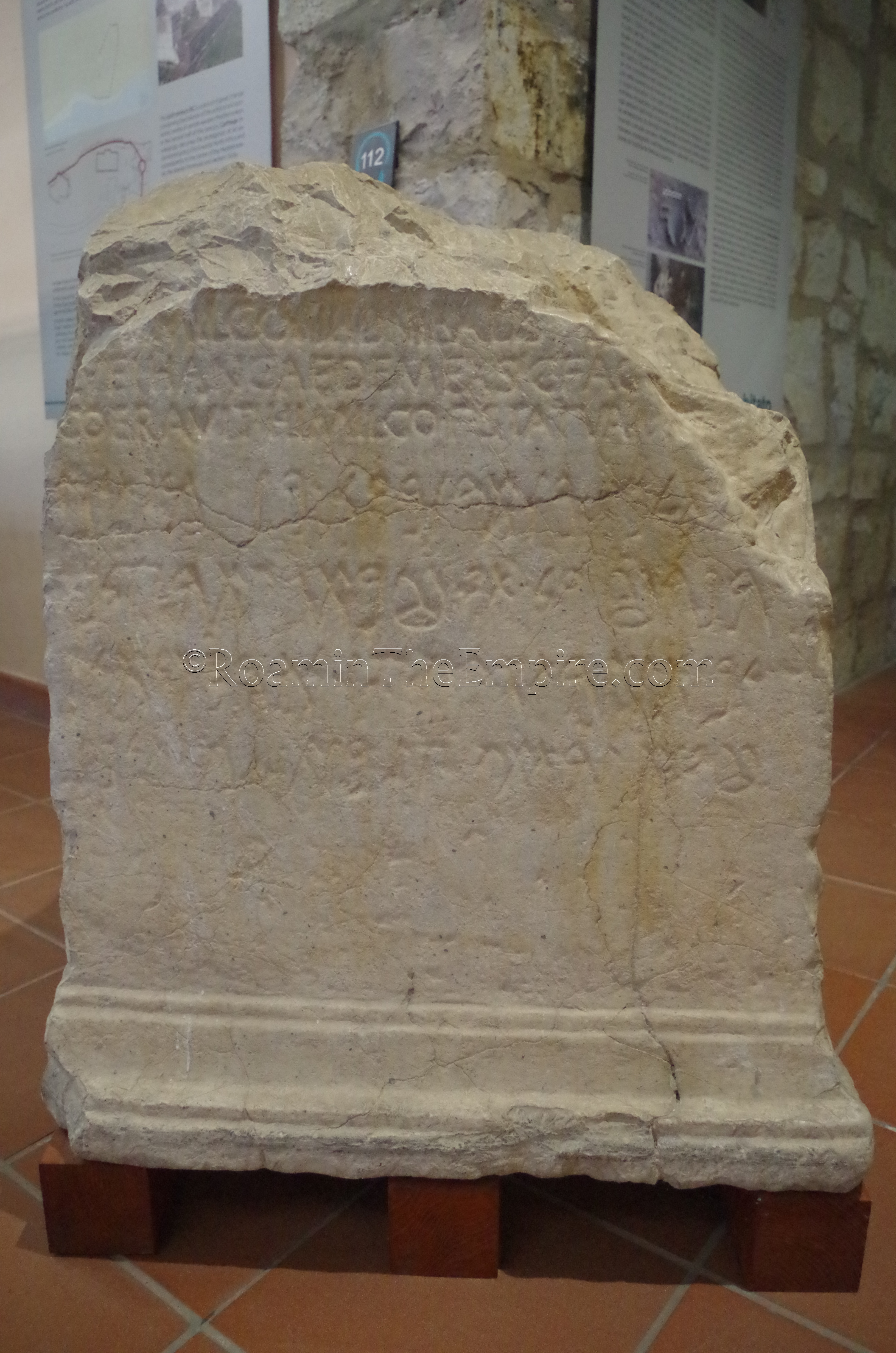
History
Referred to as Plumbaria during Roman times, due to the lead deposits mined on the island, the present-day Isola di Sant’Antioco seems to have been inhabited by the Nuragic culture as early as the middle of the 2nd millennium BCE, and the pre-Nuragic Ozieri even earlier. Sometime around 750-740 BCE, the settlement of Sulcis (or Sulky as it was originally known) was established on the east side of the island by Phoenician traders from Tyre as part of the Western Mediterranean trade network being established by the city. Sulcis seems to have been the earliest permanent Phoenician colony established on Sardinia, with the goal of controlling trade routes and the extraction of resources from the island. In particular, Sulcis seems to have had especially strong trade contact with the Greek colony of Pithekoussai (modern Ischia) and Phoenician colonies in Iberia. Sulcis itself established an inland satellite settlement 13 kilometers away at Monte Sirai.
By the 6th century BCE, the power of Tyre had waned and the Phoenician colonies in the west were left to operate largely independently, with Carthage emerging as the preeminent among them. Carthage sent military expeditions to Sardinia throughout the 6th century BCE, and a treaty concluded with Rome in 509 BCE established Carthaginian hegemony over the island, including Sulcis. The pre-Punic Phoenician settlement seemed to have integrated with the local populations to some degree, but the increasing Carthaginian control over the Phoenician colonies in Sardinia lead to a more uniform culture emerging.
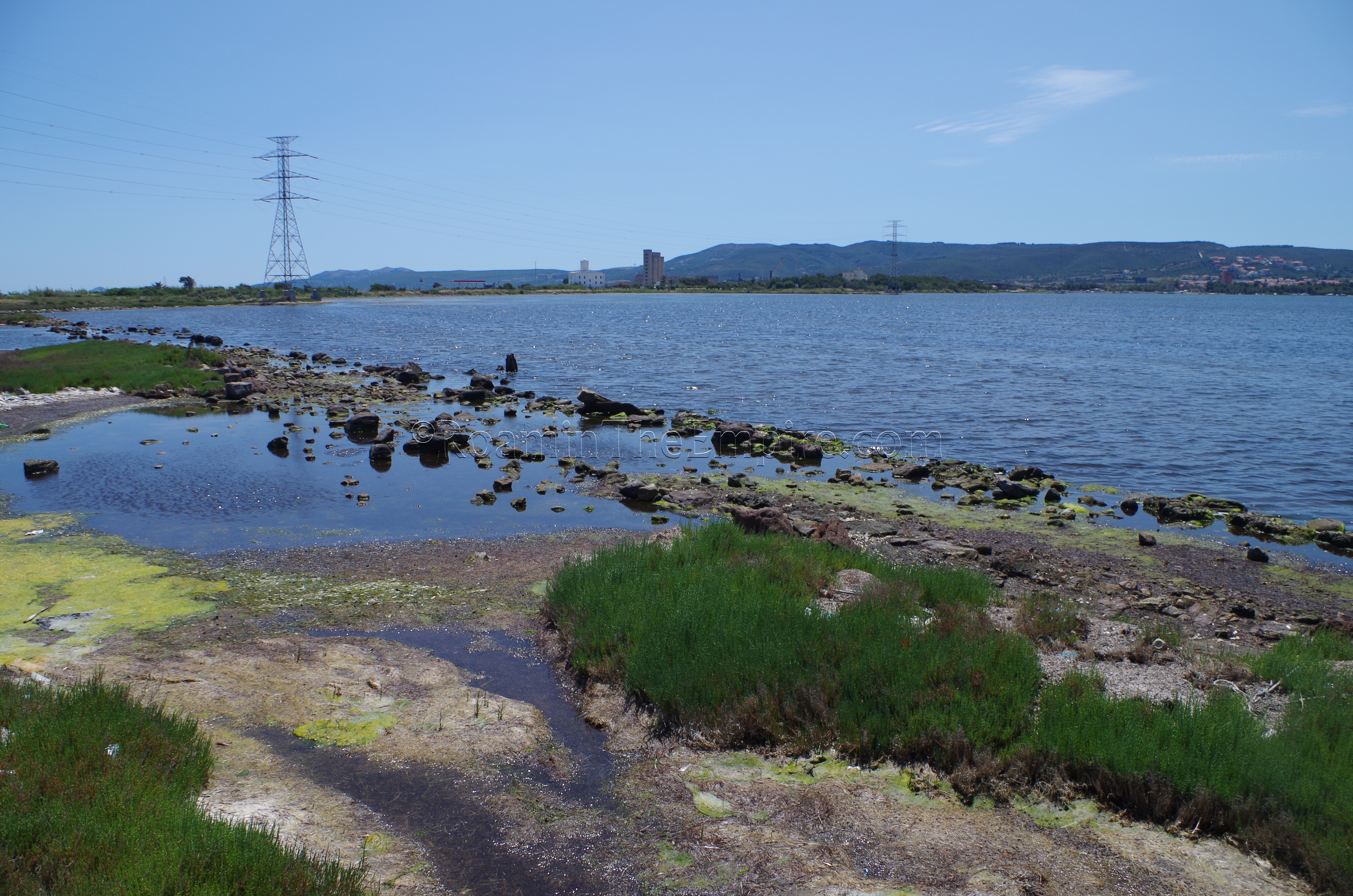
In 258 BCE, during the First Punic War, a naval battle was fought near Sulcis between Gaius Sulpicius Paterculus and Hannibal Gisco. The Romans were victorious in the battle, sinking most of the Punic ships, but with Hannibal Gisco and others escaping and seeking refuge in Sulcis. Shortly thereafter, the remaining Carthaginian troops mutinied against Gisco and executed him. Shortly after the conclusion of the First Punic War, Sulcis was annexed along with the rest of Sardinia by the Romans. Under Roman administration, an artificial causeway was built linking the island with Sardinia proper. During the civil war between Caesar and Pompey, Sulcis sided with Pompey and was punished by Caesar with penalties and confiscations in 46 BCE.
The city seemed to have recovered quickly, and by the time of Strabo was noted as being the second most important city in Sardinia. Also sometime in the 1st century CE, Sulcis was granted municipium and enrolled in the Quirina tribe. The city served as an important embarkation point for minerals mined in the area. A number of large building projects continued through the 1st and 2nd centuries CE, as attested to by inscriptions found. Sulcis maintained strong trade contact with Africa throughout the Roman period.
Getting there: The public transport network on Sardinia is not especially extensive or geared towards tourists. As such, like many of the sites I visited on my travels through the island, a car is nearly a necessity. It is possible to get to Sant’Antioco via public transport from Cagliari, but it requires a train and bus connection and takes about 2 and a half hours each way. The easiest way to do this seems to be a train from Cagliari to Carbonia, and then the 827 bus from Carbonia to Sant’Antioco. Fortunately, the routes and timetable are accessible through a Google Maps public transport route search. The bus routes only run a few times a day each way, though.
Bridge and Road
When arriving to Sant’Antioco, there are two sites outside the city that are worth stopping. On the road into Sant’Antioco, right before turning on to the causeway that leads to the city, there are the remnants of the Roman road leading out of Sulcis toward Caralis on the west side of the modern road. Unfortunately, the land is quite marshy and not easily accessible. It’s a bit of a drop (a meter, maybe) down a retaining wall along the road to get a closer look, but the marshy land prevents close inspection. There’s a pretty clear stretch visible for at least 150 meters in the shallow water, and it continues into the marshy land (which is more difficult to see from the ground, but is clear on satellite pictures) up until where it actually intersects the modern road.
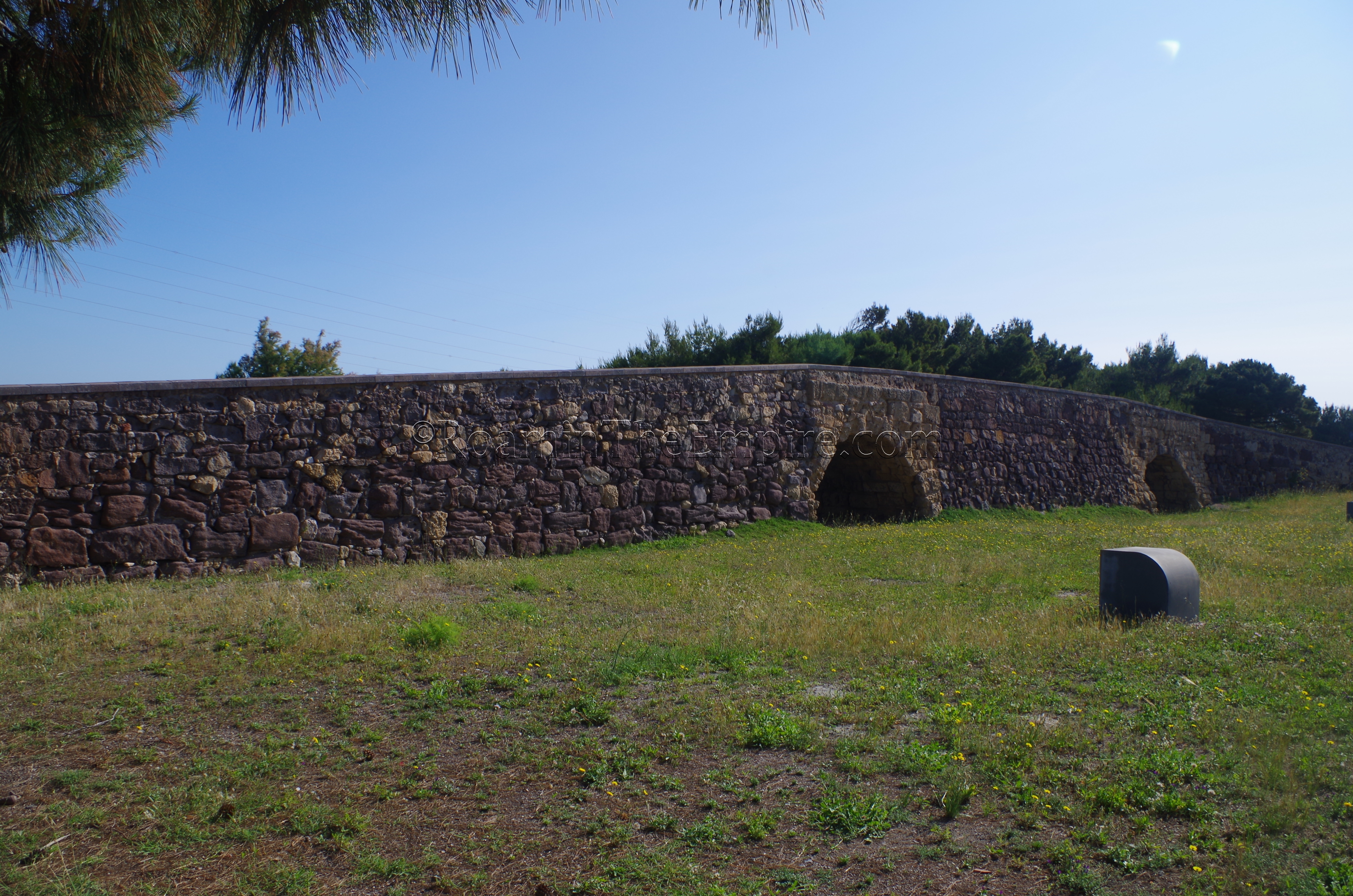
A bit farther on, before passing over the modern bridge to the city, are the remains of the Ponti Mannu (‘big bridge’ in Sardinian). Just before reaching the bridge, when coming from the ‘mainland’, there is a turnoff that allows access to a road where one can visit the bridge. Originally built in the 2nd or 3rd century CE, the bridge spanned a channel that ran through the causeway connecting the island with Sardinia proper. This bridge was still in use as late as 1954, with many restorations in the intervening centuries, when it was the primary bridge in a series that spanned channels in the causeway maintaining connection with Sardinia. There is an informational sign with a partial English translation on site.
Museo Archeologico ‘Ferruccio Barreca’
If arriving by car, the best place to start in the main part of the city is the Museo Archeologico ‘Ferruccio Barreca’ located at Via Sabatino Moscati on the north side of the city. One reason for this is that there is ample free parking available at the museum, but the information at the museum also provides a good overview of the ancient city. The museum is open every day between 9:00 and 19:00. Admission to just the museum is 6 Euros but for 7 Euros one can purchase a combination ticket to the adjacent Punic tophet (recommended).
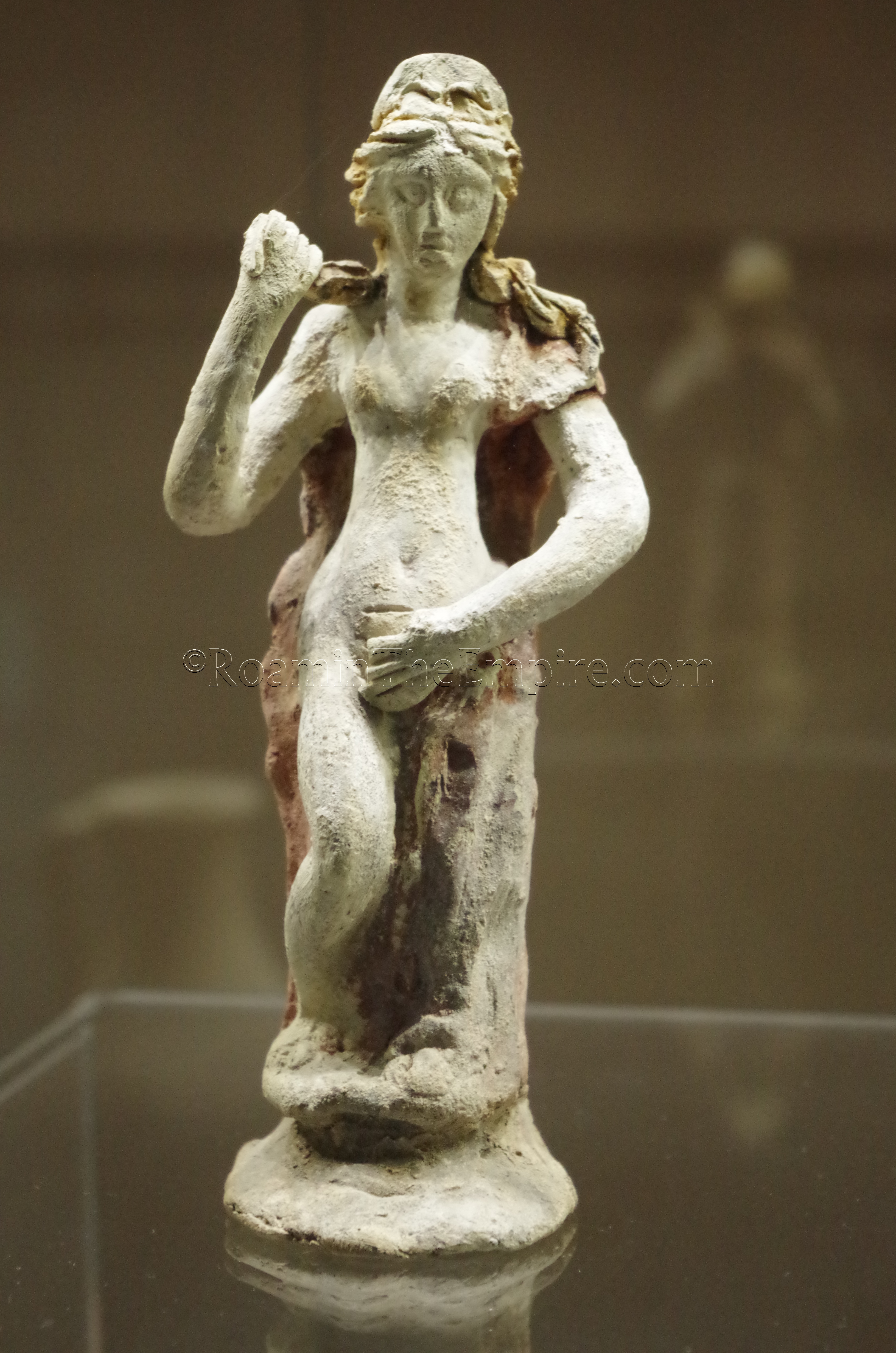
The museum is understandably heavy in Phoenician/Punic objects, particularly grave goods from the necropolis and tophet, both of which are primarily pre-Roman Punic in use. As such, there are a lot of smaller objects like jewelry, ceramics, and other smaller terracotta and bronze objects. There are also a number of stele from the tophet.
There are a few Roman objects, but it’s a very small percentage in comparison to the entire museum collection. Among these are small votives and pottery, but also a few larger statue fragments, a mosaic, and inscriptions. Also on display are two lion balustrades that were from the amphitheater. Perhaps the most interesting pieces is an inscription in Punic and Latin. Unfortunately, the inscription sits inconspicuously with no information whatsoever; which seemed to be a theme with the Roman objects (the statues and mosaic had no identifying information either).
Overall, there is a lot of information at the museum, though. There are more than two dozen informational signs about various aspects of ancient Sulcis and the museum collection, most with at least an English summary of the information. Aside from a few, mostly Roman, objects, most artifacts had descriptions. It’s a pretty well put together museum and took me about an hour to go through, not including the video at beginning, which was about 10-15 minutes.
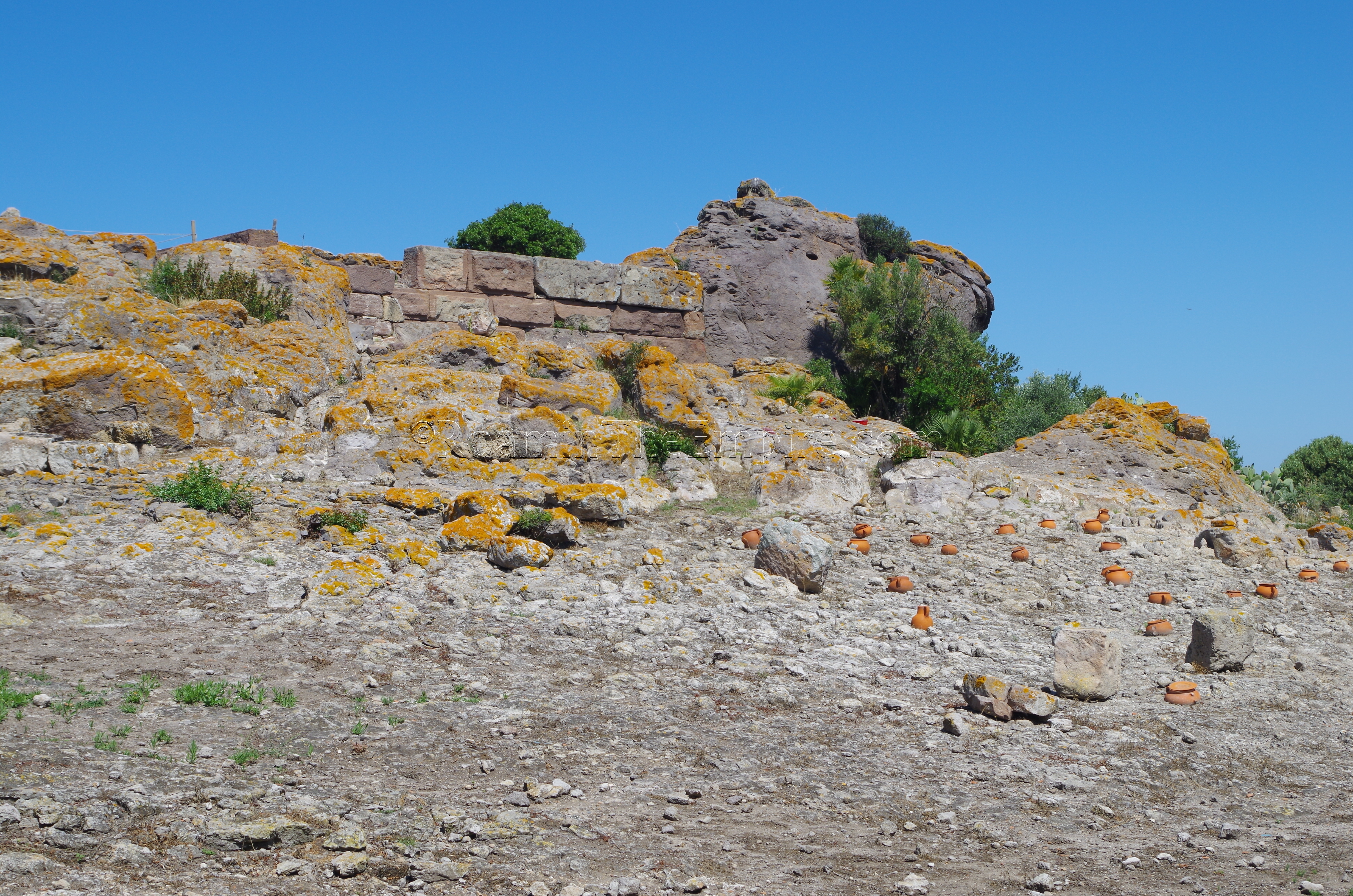
Back at the ticket office of the museum, one can gain access to (or purchase a ticket for) the Punic tophet, which included a guide. Originally thought to be a ritual space associated with child sacrifice, it is now believed that the tophet is more akin to a cemetery for children that died before they became members of the community, and eligible for burial in the standard necropolis. The tophet is located on a rocky outcropping behind the museum where the cremated remains of the children would have been buried along with dedications to Punic gods. The tophet was used as a burial space between about 750 BCE and 50 BCE, well after the Romans extended control over the island. After that point, though, the tophet was not used, nor was it appropriated for any other function.
The tophet has been extensively excavated, so very little remains in-situ, but there are a number of stele and cinerary urns placed around the site. I was told that despite the exceptionally well-preserved nature of those artifacts, they were originals and not reproductions. At the top of the tophet, there are some fortifications dating to the building of the Punic city walls in 397 BCE. The tophet seems to have been a fortified fallback point of refuge in the city’s defenses. There may have also been a cistern located at this point.
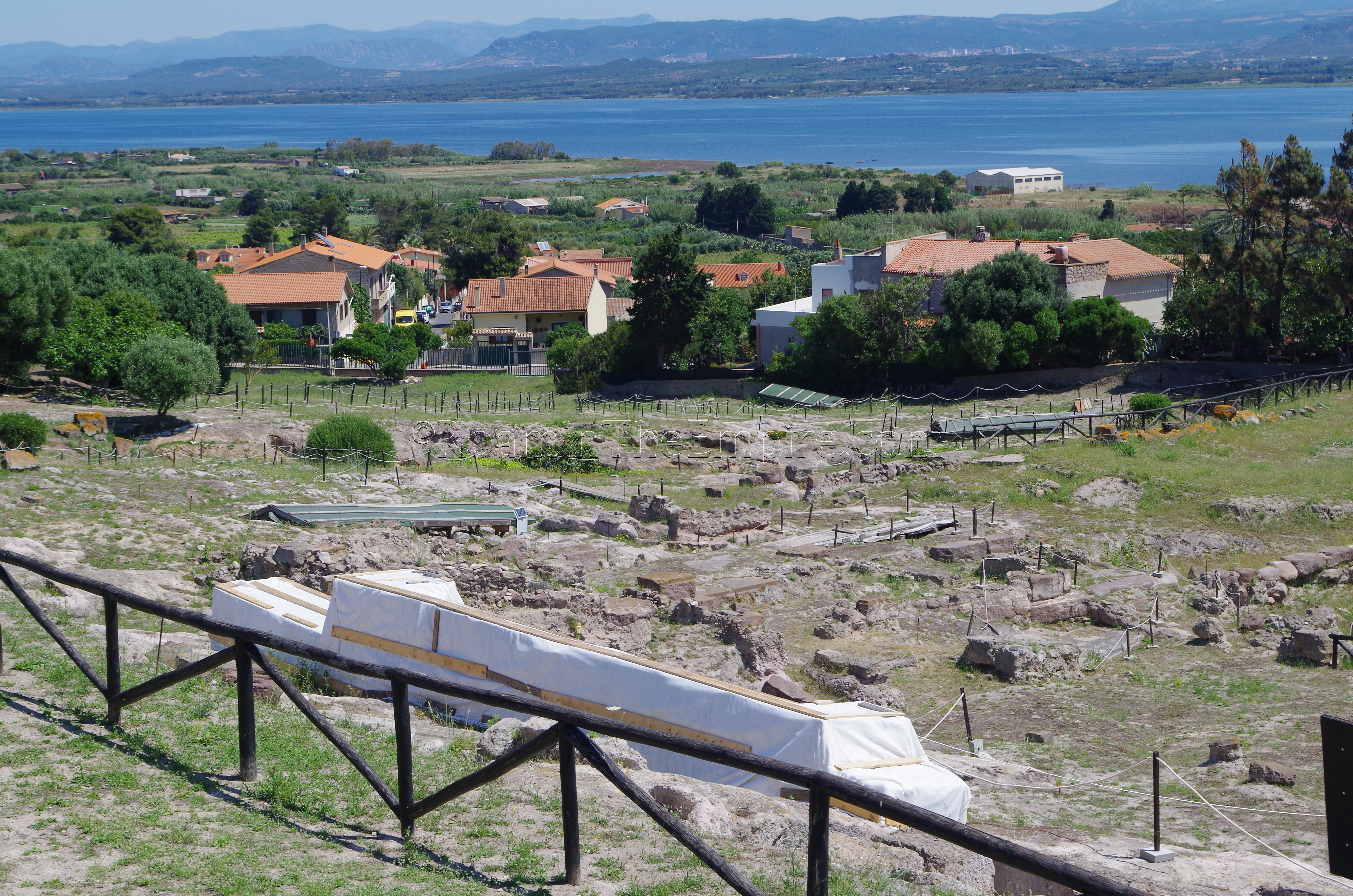
Necropoli and Acropolis
A short walk from the tophet is the Necropoli di Is Pirixeddus. Unfortunately the necropolis was closed for works when I visited (June 2019). There did not seem to be any kind of timetable for a reopening of the site. The necropolis is, however, partially visible from Via Castello, which runs above the necropolis on the west. This necropolis was used during both the Phoenician/Punic periods of the city as well as into the Roman administration (though the Romans did use other areas for burial in addition to this necropolis). It was used at least as late as the 1st century CE, and possibly as late as the 4th century CE. Interestingly, part of the Punic area of the necropolis was covered over in the 2nd century CE for the construction of Sulcis’ amphitheater, which has been excavated in the southeast part of the cemetery (and is similarly inaccessible).
Though the Necroplis di Is Pirixeddus is not accessible, one can get a look at some of the hypogeum tombs (which were subsequently cleared out and used as dwellings) in the Villaggio Ipogeo a few streets to the west, at Via Necropoli 18. The Villaggio Ipogeo is open daily from 9:00 to 20:00 in the summer and from 9:30 to 13:00 and 15:00 to 18:00 in the winter. Admission is 2.50 Euro and tickets can be purchased from the Museo Etnografico Sant’Antioco about 50 meters down the road, to the north.
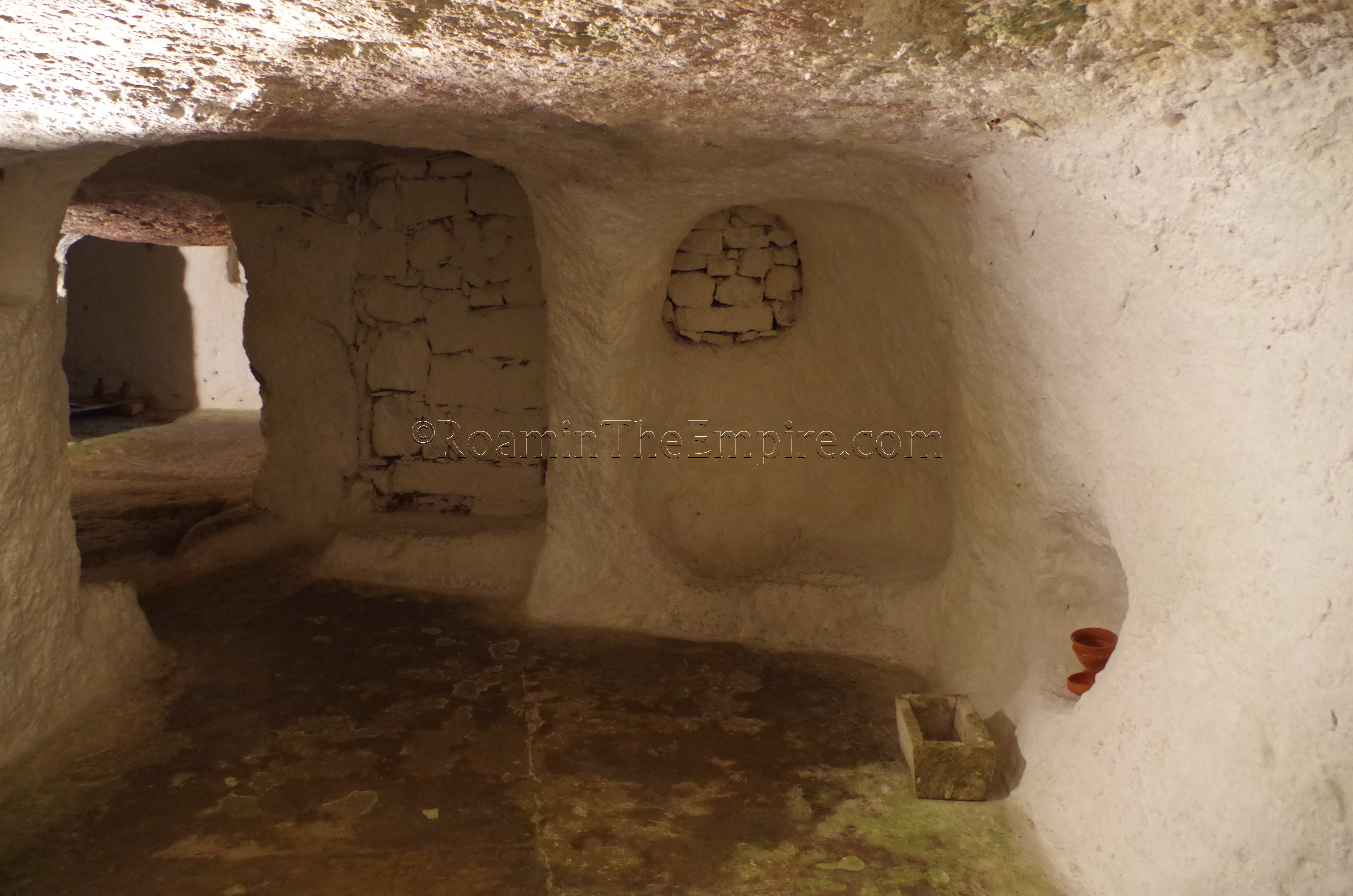
Like the tophet, a visit to the Villagio Ipogeo includes a guide, who will take you through a few of the houses/tombs. The tombs in this part of the necropolis date to between the 6th and 3rd centuries BCE. Most of the houses/tombs visited on the tour were made up to look like the dwellings as they would have been when inhabited, but the elements of the tomb (benches/niches) were still discernible. A few of them even had artifacts placed as they might have been when the spaces were created as burial chambers. The tour was relatively short at about 15 minutes.
Back at the Necropolis di Is Pirixeddus, across Via Castello, are some remains of the Punic/Roman acropolis. There is no access to the structures here, they are enclosed in a fenced area that appears to be on private property. What remains, however, can be largely seen from the street. There are two main portions to what stands here; the 4th century BCE Punic fortifications, which are primarily in the northern part of the excavated area, and part of a Roman era temple in the south, marked by the nine standing column fragments. The deity to which the temple is dedicated is unknown. There is a small informational sign in Italian with a short English translation describing the remains.
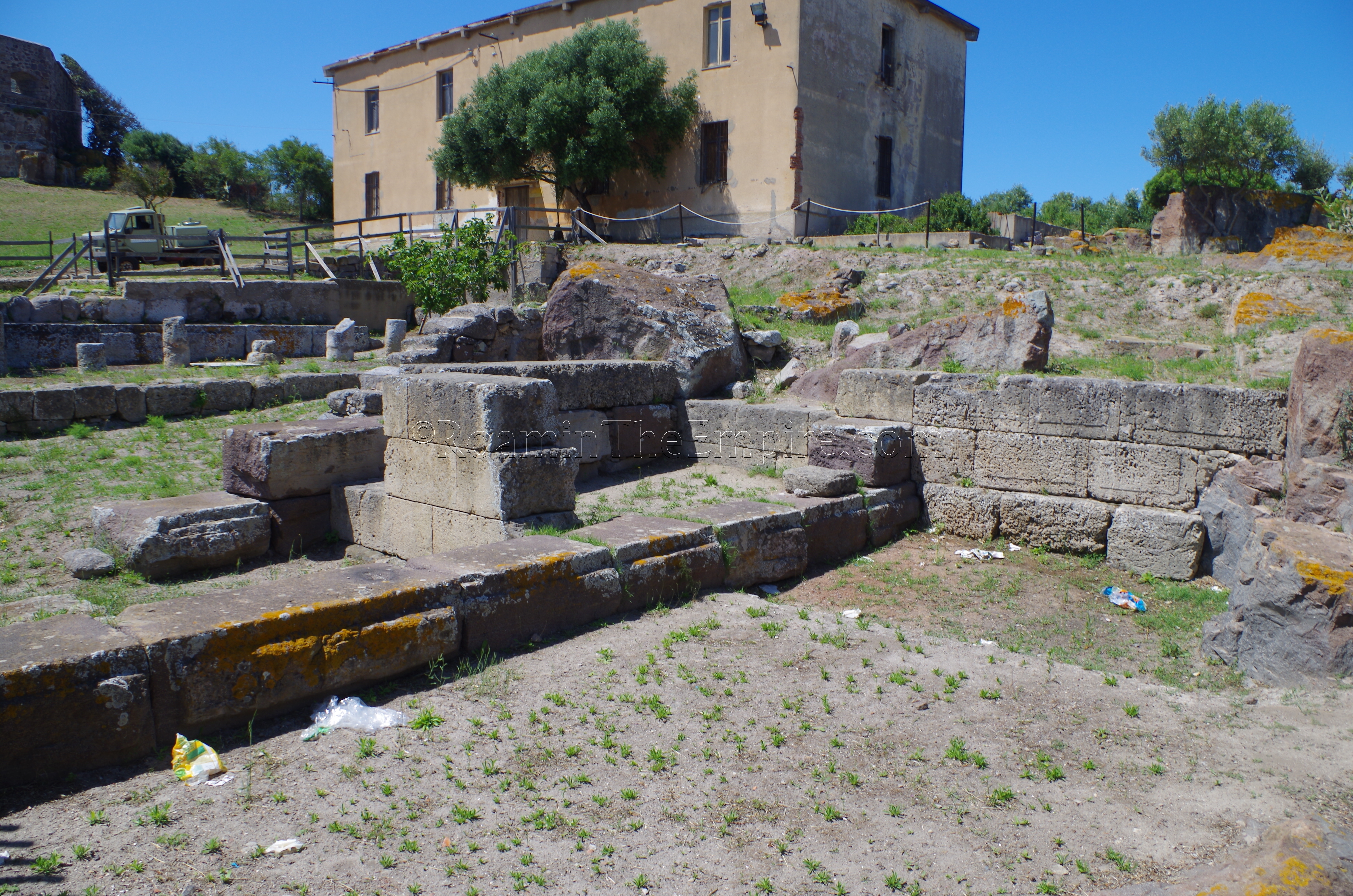
Heading south toward the center of town, there is a small excavated area at the corner of Via Borgo Sulci and Via Calasetta; essentially kitty corner from the Basilica di Sant’Antioco Martire. This small section contains the remains of what appears to be a few more chamber tombs from the Punic necropolis, though there are no signs or information.
There are also some Punic necropolis remains as well as later Roman burial chambers in the catacombs of the Basilica di Sant’Antioco Martire, which were apparently in use until the 7th century CE. Unfortunately, the entire church was closed for renovations when I visited. The regular hours for the catacombs are sort of vague and complicated. During the summer, the catacombs are open from Monday through Saturday from 9:00 to 12:00 and 15:30 to 17:30. Sundays they are open from 11:00 to 12:00 and 15:30 to 18:30. This is, except for July through mid-September, they are open Monday through Friday from 19:00 to 20:00 and the same hours on Sunday. In the winter, the catacombs are open Monday through Saturday from 9:30 to 12:00 and 15:00 to 16:30, and Sundays from 15:00 to 17:00. Admission is 5 Euros.
Mausoleum and Fountain
A bit further on, at the intersection of Via Eleonora D’Arborea and Via XX Settembre are the remains of a Roman mausoleum, known locally as ‘Sa Tribuna’ or ‘Sa Presonedda’. The monument is not in a great state of preservation as it appears as just a mound of blocks and cement for the most part. The tomb dates to the 1st century BCE, and incorporates elements of Punic construction techniques and style, which were still in use in the 2nd and 1st centuries BCE in Sulcis. The tomb is fenced in, so there is no direct access, and it is not possible to gain entrance to the interior. There is an informational sign with Italian and English posted on the fence.
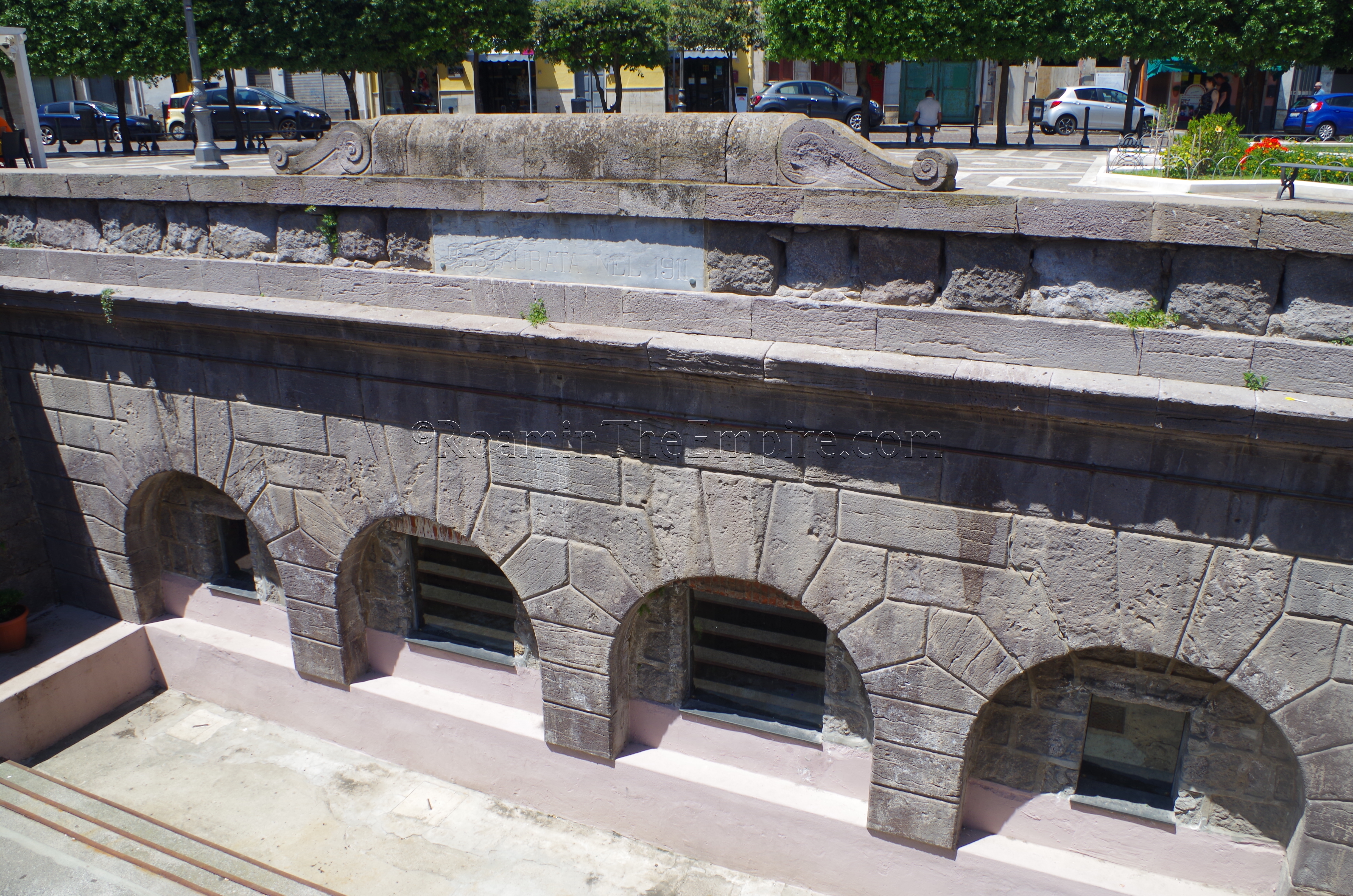
The final monument of Roman Sulcis is near the center of the modern town; the Is Solus Roman fountain. When I first saw the fountain, I thought that a modern façade had been constructed over the fountain, and the actual Roman fountain was protected behind the exposed wall. In actuality, it is an early 20th century restoration that makes it look much more modern than ancient, unfortunately. There are a few blocks that look like they could be from antiquity, but most of them do not. There is no information available on-site.
While there are quite a few things to see from antiquity in Sant’Antioco, most of them are pretty quick visits, and so the remains of ancient Sulcis are very easily a half a day (it took me about three and a half hours to see everything).
Sources:
Dyson, Stephen L. and Robert J. Rowland Jr. Archaeology and History in Sardinia from the Stone Age to the Middle Ages: Shepherds, Sailors, & Conquerors. Philadelphia: University of Pennsylvania Museum of Archaeology and Anthropology, 2007.
Hoyos, Dexter. The Carthaginians. New York: Routledge, 2010.
Miles, Richard. Carthage Must Be Destroyed. New York: Viking, 2011.
Pausanias, Description of Greece, 10.17.19.
Smith, William. Dictionary of Greek and Roman Geography. Walton & Murray, 1870.
Stillwell, Richard, William L. MacDonald, and Marian Holland. McAllister. The Princeton Encyclopedia of Classical Sites. Princeton, NJ: Princeton U Press, 1976.
Strabo, Geographica, V.2.7.


